A furious, drenching rain pours down on the flight line at Bagram Airfield, Afghanistan. It’s just after 3 a.m. on a recent Monday. Despite the hour and the weather, C-130s, C-17s, a giant C-5, and even a reconditioned Vietnam War-era C-7 pass back and forth on the taxiways and ramps.
Other Air Force and commercial aircraft are parked in rows on the aprons. Most of these are being loaded, unloaded, or refueled and readied for more missions. The engine noise and activity are relentless.
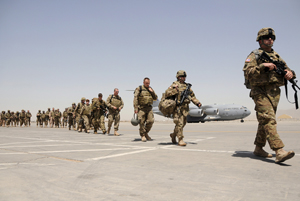
| ||
|
Troops, including airmen from McEntire JNGB, S.C., arrive at Kandahar Airfield, Afghanistan, in June. (USAF photo by TSgt. Caycee Cook) |
“This is 24/7, 365, here,” declares Lt. Col. Daniel Lemon, then commander of the aerial port squadron at Bagram, referring to the heavy flight line activity. If possible, that’s an understatement.
Lemon oversees a vast materiel processing operation at Bagram. The materiel arrives by air, gets sorted into vast aisles of outdoor steel-wire shelves and parking lots, and then heads out again—usually within a few days. From Bagram, supplies are delivered to forward operating bases—or FOBs—scattered across Afghanistan.
Conversely, wheeled vehicles such as Humvees and MRAPs as well as other heavy equipment will usually be loaded on aircraft for “retrograde”—that is, for withdrawal from Afghanistan for pre-positioning depots elsewhere in the region or return to the United States.
Almost certainly, there will be no letup in this operating tempo for some time. Under the strategic agreement signed in May between President Barack Obama and Afghan President Hamid Karzai, US forces will steadily withdraw from Afghanistan. Responsibility for the country’s security will slowly be handed off to Afghan Army and police forces.
As US personnel depart, the first to leave will be those ground forces handling logistics and support—the forces that have previously brought supplies overland with convoys.
The last to go will be the combat troops positioned at the many remote FOBs and the airmen who sustain them. Those remaining ground forces will depend more and more on airlift for every basic need—food, water, ammunition and fuel, to name a few.
Flexible and Agile
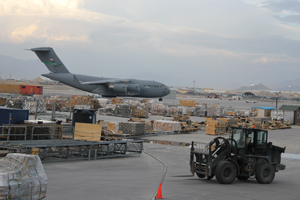
| ||
|
A C-17 taxis in at Bagram Airfield, Afghanistan, the busiest aerial port facility in USAF, by far. About 98 percent of incoming cargo reaches far-flung forward operating bases within 72 hours of arriving at Bagram. (Staff photo by John A. Tirpak) |
Already, an estimated 27,000 US troops in Afghanistan have become wholly dependent on airlift for these needs. That number is expected to steadily increase.
In Afghanistan, the quantity of airdropped supplies has risen dramatically, jumping from 3.5 million pounds in 2006 up to 80 million pounds in 2011.
As the number of troops on the ground begins to decline, the airdropped volume of goods also will decline, though airdrop will constitute an ever-greater percentage of the total resupply effort.
“We are on track to do roughly the same amount that we did in 2010,” said Col. Jacqueline D. Van Ovost, mobility director for US Air Forces Central. She added that 2011 was the spike year. Numbers in 2012 have declined somewhat because of reductions in personnel and other factors.
However, she said, the FOBs are becoming “more isolated” as the drawdown progresses, and that fact increases their need for resupply by air. The FOBs also don’t have the facilities to store large quantities of supplies, she noted, and must rely on just-in-time shipments.
The Air Force has great flexibility. It can use large C-17s that can air-drop 40 pallets at a time. Or it can go small with a C-130 delivering a half-dozen pallets.
For homeward redeployment of forces through 2014, USAF is using C-17s and C-5s primed for “multimodal” operations. That means these aircraft haul heavy gear such as vehicles or helicopters out of Afghanistan to a Middle East airfield near a seaport. After a quick transfer, the equipment moves the rest of the way to its final destination by sea, thus reducing overall cost.

| ||
|
A C-130H assigned to the 774th Expeditionary Airlft Squadron—the “Weasels”—is serviced at Bagram. Airlifters must vault the Hindu Kush range in the background on their multiple daily missions. (USAF photo by Capt. Raymond Geoffroy) |
This multimodal way became essential, said Van Ovost, after Pakistan last year froze convoy US shipments to and from the Karachi seaport. Wheeled and rail traffic over the Northern Distribution Network through Uzbekistan and other countries picked up the traffic.
The multimodal concept also has been exercised for inbound deliveries.
In an interview, Lemon reported that USAF mobility forces currently carry out about 110 missions a day, in and out of Afghanistan. His organization in any 24-hour period can cope with loading and unloading seven aircraft—three widebodies and four narrow-bodies.
Still, there is usually a backlog. As Lemon was speaking, a gigantic Russian Antonov Il-76 and a commercial 747 shared the ramps with a dozen or so USAF “gray tail” airplanes. On the other side of the airfield, Army attack and utility helicopters, USAF rescue helicopters, A-10 attack airplanes, and various remotely piloted aircraft went about their missions.
Increased Velocity
Lemon’s organization pushes to make sure materiel doesn’t sit idle. “The goal is to get the cargo out to the FOBs in less than 72 hours,” he said. “Over the years, the workload has increased, but we’re getting better with our velocity output.”
He displayed a chart showing that in August 2010, the percentage of monthly cargo pushed on to its final destination within 72 hours stood at 55 percent. By January 2012, the figure had reached 98 percent. There it has remained.
Lemon credits some of the increased velocity to major improvements at Bagram’s Air Terminal Operations Center, an aerial port much like those at Stateside locations at Dover AFB, Del., or JB Charleston, S.C. There’s fresh concrete, modern hangars, and plenty of forklifts and loaders.
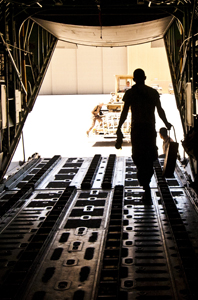
| ||
|
Airmen of the 455th Air Expeditionary Wing prepare to load cargo on an Air National Guard C-130H at Bagram in June. As the US draws down in Afghanistan, the need for air resupply of forward-based forces is increasing. (USAF photo by Capt. Raymond Geoffroy) |
Thirteen of these loaders are capable of hoisting a 60,000-pound load. Another six are of the 10,000-pound variety. Also on hand are a number of 25,000-pound-capable Halvorsens.
It’s the busiest aerial port in the Air Force. Charleston moves an average of 61 passengers and 92 tons of cargo each day. At Travis AFB, Calif., the figures are 113 passengers and 116 tons of materiel. In stark contrast, Bagram each day handles an average of 1,475 passengers and 600 tons of cargo.
“Any time there’s a huge Army or Air Force unit going in or out, they go through us,” Lemon said. “We synchronize their strategic lift out of here, we help them organize their cargo, we let them know their pax [passenger] show times, [and] coordinate with the TACC,” or Tanker Airlift Control Center.
The work complement is a mixture of about 40 percent Active Duty and 60 percent Guard and Reserve personnel. Active airmen, who deploy as part of an air mobility expeditionary force, will come for about 120 days, though most overstay that limit. Guardsmen and Reservists, though, will usually split a deployment with another person, with each filling a job for about 60 days.
Lemon’s group works closely with Air Forces Central’s directorate for air mobility. The group gets a clear picture of what’s coming in and plans days or weeks in advance as to how to marry up the cargo arriving with the tactical aircraft on hand.
Load planning, Lemon said, is “like a Tetris game; we try to optimize every piece of airlift, every cubic feet of space of that aircraft so that we don’t fly anything empty.”
Knowing what’s on an aircraft at all times is of premier importance. This fact became all too evident at dawn on one recent day in Afghanistan. An Air Force C-130—loaded, engines turning, ready to take off—was unable to depart for an hour. There had been a failure of the local network keeping tabs on aircraft and the loads they carry. That meant neither AFCENT nor the TACC at Scott AFB, Ill., could “see” what was moving. Only after the network came up again could the C-130 take off. It promptly taxied, rose, and vanished as it headed toward the Hindu Kush mountains to the north.
Most of the cargo from Bagram goes to the FOBs on C-130s. They do this in one of three ways.
The typical delivery is called an air-land mission; the C-130 takes off and flies to a short airfield adjacent to a FOB.
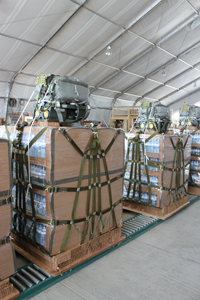
| ||
|
Bundles topped with the Joint Precision Airdrop System await loading at Bagram’s pallet-building facility. The satellite guidance systems allow extremely accurate airdrops. (Staff photos by John A. Tirpak) |
Then, there are two kinds of airdrop missions. In one, airmen drop unguided bundles of supplies by parachute. The other method features the Joint Precision Airdrop System; a GPS-aided steering mechanism guides the dropped load to a specific point.
Our Friends: Speed and Altitude
In air-land missions, say crew members, airfields can be extremely rudimentary—a dirt road, loose gravel—all the way up to a well-built short concrete runway of 3,000 feet or so. After a decade of Operation Enduring Freedom, more than half the FOBs have sturdy runways, but austere strips still abound.
Since most of the FOBs are in contested areas, flight crews wear body armor and helmets. The cockpit walls and floor have been paneled with sheets of Kevlar, and pilots make an aggressive approach, with gut-wrenching, high-rolling turns to quickly bleed off altitude and airspeed.
“Speed is our friend and altitude is our friend,” said Lt. Col. John Strike, chief of tactics with the 774th Expeditionary Airlift Squadron at Bagram. The C-130s will usually “fly a high profile … and then, [swiftly descend] the last five to 10 minutes of the mission.”
Thus far, say aircrew members, the enemy has not used shoulder-fired missiles, though they are prepared for it. “All but one of our airplanes have … countermeasures on them, and all our crews are qualified in it,” Strike said.
Crews do, however, routinely discover holes in their aircraft caused by small-arms fire. A round from a standard AK-47 Kalashnikov assault rifle can reach about 3,000 feet. Pilots keep this in mind. Rocket-propelled grenades are another common threat.
Most of the protective measures are taken mindful of rifles and RPGs, said Strike, because “we’re dropping down low; that’s going to be the small-arms threat.”
Upon landing, the aircraft will taxi to a safe spot or revetment adjacent to the FOB. Two Air Force security forces personnel, called a FAS (Fly Away Sentry) team, are the first off the aircraft, taking up stations at either wing tip to protect the aircraft and crew, and give cover for the unloading process.

| ||
|
A C-130H from the West Virginia Air Guard takes on a paradrop load. The aircraft is fitted with anti-missile countermeasures, but assault rifles and rocket-propelled grenades are the more common threat. (Staff photos by John A. Tirpak) |
A C-130H can carry 16 pallets of cargo; a C-130J can carry 20; and in both cases, if there is appropriate gear at the destination, the aircraft can be unloaded in just a few minutes.
Strike said at some bases where there is no offloading gear available, loadmasters will simply unhook the parcels from the cargo deck while the aircraft is stationary. A sudden burst of engine power, and inertia alone will drop the pallets the few feet onto the landing strip.
Once offloaded, a C-130 will make a hasty exit. Often, it will drop off only half or less of its load, then go on to another or several more FOBs, in what some crews call a “round robin” sortie, eventually winding up back at Bagram.
For an airdrop, crews will contact the FOB well before reaching the drop zone, to make sure the zone is secure and that someone is anticipating the delivery and is ready to collect it. In fact, the aircraft can’t drop unless the ground officer gives the all-clear.
If radio contact with a FOB is lost, there are other ways the crew can communicate with the recipients on the ground, including e-mail or with colored smoke. Only rarely does a problem prevent the aircrew from dropping its bundles, called the Containerized Delivery System, or CDS.
Seconds before reaching the drop zone, the C-130’s loadmasters cut the cords holding the bundles to the aircraft, and the units slide, one by one, out the rear cargo door.
The pilots don’t swing the Hercules around to see the parade of parachutes or whether they reach the intended landing zone, though.
“That’s a big no-no,” Strike said. “Planes that go over the same spot more than once typically get shot at. … You just don’t do that.” Feedback on the quality of the drop is usually provided by the Army or Marine ground logistics officer later, by phone or in an e-mail. Typically, it’s a short message amounting to, “Thanks a lot, we’ve got it,” one loadmaster said.
A staple of C-130 deliveries in Vietnam, the LAPES technique—for Low-Altitude Parachute Extraction System—was discontinued about 15 years ago and has never been used in Afghanistan. With LAPES, a C-130 would fly almost low enough to land. A parachute would deploy out the back door, pulling the cargo out to land—hard—on the ground below. The technique was “impressive” but just too rough on the dropped equipment, Strike said.
The JPADS, which is used today, looks like a chunky green suitcase strapped atop a cargo pallet. With two large yellow dials suggesting eyes, the unit has a robot-like appearance when affixed to the top of a load. On its “head” it wears a disposable parachute or set of three parachutes, depending on the deployment altitude and the nature of the cargo. The JPADS and CDS loads are built identically, with the control unit the only difference between them.
In the Back of the Truck
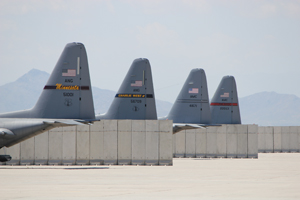
| ||
|
C-130s from all over the Air Force line the ramp at Bagram. At least one C-130 is kept on alert at all times for emergency resupply of a unit low on ammo, food, or water. (Staff photos by John A. Tirpak) |
An Army unit at Bagram builds the bundles around the clock. A typical airdrop bundle will include four drums of fuel, topped by crates of food and bottled water, but standard loads exist for all combinations of materiel, to include everything from ammunition and weapons to energy drinks and ice cream.
A joint airborne inspector, who could be Army or Air Force, comes aboard the aircraft before takeoff to ensure the loads are attached properly to the drop wire and are ready to go.
The JPADS unit incorporates GPS guidance with actuators attached to the parachute rigging. It can steer the wing-style parachute to a precision landing.
Upon approach to the landing zone, the loadmasters will switch on the individual units, which glow to life with the message “ready to fly” on their small display screens. The loadmasters then throw air sondes out the back of the aircraft. The instrument probes—about the size of a can of tennis balls with a rounded metal bottom and a parachute—send the JPADS units information about the location and prevailing winds. This communication link is painstakingly checked before the mission even launches, as air sondes that have long been in storage may take a while to “wake up” and recognize where they are.
The value of JPADS is that loads can be released in any weather, and thanks to the steering capability, the dropping aircraft need not directly overfly the drop zone but can offset a significant distance to avoid ground threats. The aircraft also can drop from a higher altitude—particularly important if the aircraft is at 18,000 feet dropping to troops at 12,000 feet, or when the drop zone is in a valley where an aircraft wouldn’t have enough room to descend, drop, and climb back out.
Strike said the Army officer on the ground will choose the aimpoint for a JPADS delivery, but with USAF’s advice on avoiding “collateral damage—houses, buildings,” and other obstacles to avoid. A 100-yard landing zone is typical.
“They’d like it right in the back of the truck if they could,” Strike noted. “Unfortunately, we don’t do that.”
Unlike a GPS guided bomb, which is largely unaffected by winds, he explained, a load on a parachute is at the mercy of wind shear and sudden gusts and must compensate more slowly. The precision of JPADS is good but not quite so pinpoint as a bomb. Strike said there have been no complaints about its accuracy, though.
The C-130 unit at Bagram maintains an alert aircraft in prepped condition, preflighted and ready to go at a moment’s notice if there’s an urgent request for resupply, such as from a FOB running out of ammunition. Strike said some personnel are always in crew rest and ready to go, and the Army rigging unit has bundles ready to go with fuel, ammo, water, and other emergency supplies.
For one such mission in May, the crew arrived at the aircraft only 15 minutes after the call came in from AFCENT’s air mobility directorate. The airplane was loaded and ready to launch about an hour after receiving the mission. After that, it was an 80-minute flight to the FOB; “we go as fast as we can,” Strike said. The needed water and ammunition reached the FOB well before the base ran dry.

| ||
|
In 1991, USAF fighter aircraft pass oil fires, set by the Iraqi Army in retreating from Kuwait during Operation Desert Storm. USAF fighters downed 37 enemy fighters, with no losses, in that war. (USAF photo) |
“As they keyed the mike, we could hear the machine gun fire in the background, so they were real happy to get the ammunition,” Strike said. The mission, and others like it, was a “pretty rewarding thing to do.”
Lemon noted that on many occasions, a C-130 has been held waiting for an inbound C-17 with a blood shipment.
“Our guys will literally run out to the plane and hand it to the loadmaster. … We had one story where the plane went to the FOB, a nurse met the plane, took the blood and went to the operating room.”
Beyond 2014
The C-130 is complemented in the airdrop role by the C-17, which can land at some FOB strips if necessary, and previously by the C-27J. The large C-17s can do a major airdrop, with the ability to release 40 bundles at a time, while the C-27J was used to support brigade-level Army units Van Ovost noted. Both aircraft require some 3,000 feet of runway, and, she asserted, the C-27 was more efficient than the C-130 only when sending a small load to a FOB.
A C-7 Caribou operated by a private contractor works out of Bagram, Van Ovost acknowledged, providing the Army with “one version of airdrop we call low altitude, low velocity.” In such missions, airdrops take place at very low altitude—150 feet or so—whereas the C-130 will typically drop from higher than 300 feet. The Army has the C-7 Caribou contract for these very low drops, she said. The Army decides where and when it is safe for that aircraft to operate.
The Caribou can go to locations needing one or two bundles or a single person. The C-130 cannot do the typical mission the C-7 performed in Vietnam—landing on the side of a mountain. That capability is needed so rarely that a single aircraft under contract is probably the smart way to get it, she said.
“And it is our hope, really, that commercial contractors come to Afghanistan and make a niche there,” to support Afghan forces in the years to come, Van Ovost said. One of ISAF’s goals is to leave a transportation infrastructure the Afghans can use to maintain their own army and police forces.
The new aerial port facilities at Bagram—as well as new dormitories and other, more robust structures replacing temporary lodgings that are falling apart—indicate that USAF’s mission will continue in Afghanistan beyond the 2014 date, according to Brig. Gen. Thomas H. Deale, commander of the 455th Air Expeditionary Wing at Bagram.
Deale said the new facilities are a combination of a move toward permanency and the fulfillment of contracts let in years past. But based on the strategic agreement signed in May, “we’re going to be here in some capacity in support of the Afghans beyond 2014,” Deale said. “Bagram has been a central hub for both logistics and operations” in the country almost since Operation Enduring Freedom began, “and I would expect, in some way, shape, or form, Bagram will continue to do that as we progress.”